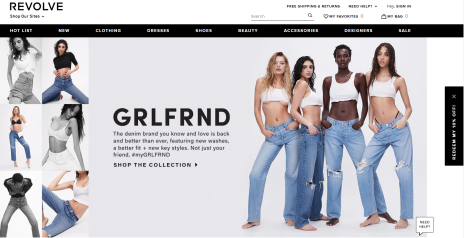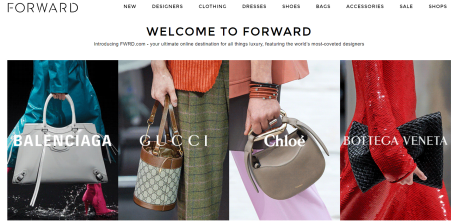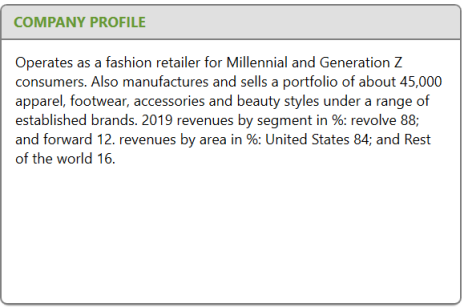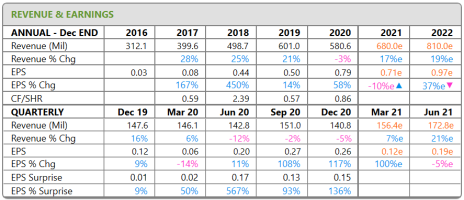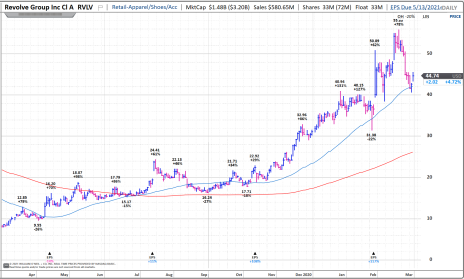The action of high-growth stocks continues to be sloppy despite the strong performance of most underlying businesses.
To help ease our portfolio thorough this period I’ve been evaluating companies with exposure to the reopening economy, and I think I’ve nailed it.
Today’s stock is an online retailer serving younger generations. These consumers should be among the most active spenders as the world opens up again. And this up-and-coming retailer should be a major beneficiary.
Enjoy!
Cabot Small Cap Confidential 263
[premium_html_toc post_id="228141"]
The Big Idea
For over a year we have been forced to hold back from doing so many things we all took for granted.
Now, with vaccination rates rising quickly, spring in the air and summer right around the corner there is massive pent-up demand to travel, eat out at restaurants, go to the mall, attend a concert, hang out with friends and so much more.
In short, people are ready to party!
There is a catch, however. While pajamas and one-piece sweatsuits were fine when working at home and for cozy movie-and-pizza nights during the pandemic, they aren’t quite right for going out on the town.
People need and want to refresh their wardrobes. Looking at data from already reopened economies, including Australia and Israel, the trend is unmistakably bullish for what should happen in the coming months here in the U.S.
Among those most likely to spend money on dresses, bathing suits, skirts, tops, shoes, jeans, etc. are the younger generations, namely Millennials and Gen Z. These generations now make up a quarter of the U.S. population and will be one of the biggest drivers of economic activity in the years to come.
They are also highly engaged online. These generations have grown up during, or were born into, a digital economy. They are influenced by social media and are quick to share, recommend and purchase items online.
Today, we will invest in an e-commerce fashion retailer that’s perfectly positioned to capture this coming demand wave.
While this company is clearly a “reopening” play, there is much more to the story and the trends supporting its business, which sports a data-driven sales approach, high order values, fat profit margins and leadership in social influencer marketing.
The Company
Revolve (RVLV) is an e-commerce fashion retailer that focuses on Millennial and Gen Z consumers (ages 18 to 39) through two differentiated websites, REVOLVE and FORWARD. The company has a portfolio of 24 owned brands, each of which has unique attributes and is supported by independent marketing and relationships with influencers. Additionally, Revolve continuously finds new brands and designers to feature on its websites.
Revolve has a market cap of roughly $3 billion and was founded in 2003 with the vision of leveraging digital channels and technology to transform the shopping experience for youthful, aspirational consumers. The business is much more targeted then generalized department stores, or mass-market online retailers.
The company is particularly strong marketing and selling premium on-trend women’s designer apparel, footwear, accessories and beauty styles. Roughly 80% of sales come from the U.S., with the remaining 20% coming internationally, primarily from Australia, Israel, the U.K., the E.U. and, more recently, New Zealand, Singapore and Canada.
Even prior to the pandemic, consumers were moving more purchasing online. This is especially true with Millennials (born between 1982 and 2000) and Gen Z (born after 2000) who have grown up in a digital world. Those generations now account for a quarter of the U.S. population.
Additionally, smaller brands with unique marketing pitches and use of influencers are outpacing more generic, large brands. Here again, Revolve excels. The company has a community of over 4,500 influencers. Prior to the pandemic the company would host large events to drive excitement and marketing buzz, including the #REVOLVEfestival, #REVOLVEsummer, #REVOLVEaroundtheworld and the #REVOLVEawards. These events were attended by top influencers, who promote both the REVOLVE brand and company merchandise. These events were largely put on hold, or moved to a virtual format, in 2020 and early 2021, but should come back as the pandemic recedes.
The return of travel, parties, shopping, events and other social engagements should drive interest in many online retails, but I expect Revolve will capture outsized market share gains, especially since its products promote aspirational lifestyles, including social events and travel.
As a quick side note, my personal experience with Revolve was what really turned me on to the company. While I had been following it from a distance for several months, a few weeks before Christmas my 5-year-old gave me his wish list, which included a Koala (“a LIVE one, Dad, not a stuffed one”) and a snowmobile.
Thankfully, the Australian Koala Foundation denied my request to import a young bear, but when searching online for “inflatable snowmobile,” Revolve popped up as one of the few retailers with one in stock. It arrived within a few days.
Nailed it!
Beyond the initial thrill of shopping on an e-commerce site designed for Millennial and Gen Z women, I was really impressed with how easy it was to complete the order from my iPhone (management says that just over half of total orders and net sales come from mobile devices) and have kept tabs on the company since.
Digging in, there is more here than meets the eye, starting with a proprietary, data-driven platform.
Products & Platform
Revolve has a built a proprietary technology platform that uses algorithms to forecast trends, determine pricing and manage inventory. Customer interaction data points are integrated with product specifications (up to 60 attributes per style) to help determine demand trends across many regions.
This data informs inventory purchases and contributes to low fashion and inventory risk, limits markdowns and keeps the e-commerce sites feeling fresh. Management says Revolve’s sites introduce over 900 new styles in an average week. Even in 2020, amidst a pandemic, 77% of products were sold at over 95% of full retail value.
Additionally, most product ships by air, thereby evading port congestion, container shortages and stuck ships in the Suez canal!
In anticipation of higher demand for going-out items, management has already begun to expand its assortment. Moreover, as people get out the company can benefit from organic marketing and greater influencer reach.
Big picture, Revolve’s use of data science means the company is much more sophisticated than one would assume, and more so than many competitors. Its platform drives immense operating efficiency, higher profits and attractive customer acquisition costs.
Revolve uses one platform to sell merchandise through two main retail segments, plus one new one. Let’s discuss those.
REVOLVE
REVOLVE offers constant newness and discovery with a broad but curated variety of premium apparel, footwear, accessories and beauty products. This segment drove the majority of sales in 2020 (86%), which fell by 5% due largely to the impacts of the pandemic. Currently featured brands include GRLFRND, Free People, AGOLDE, Alexis, BEACH RIOT, Beyond Yoga and Boys Lie.
FORWARD
FORWARD offers a curated assortment of both iconic and emerging luxury brands with strong and differentiated points of view. This segment contributed 14% of sales in 2020 and grew by 8%. Currently featured brands include Gucci, Bottega Veneta, Valentino, Chloe, Burberry, Jimmy Choo and Balenciaga.
REVOLVEman
REVOLVEman is a recent effort to branch out into men’s apparel, footwear and accessories. A few of the featured designers include John Elliott, Canada Goose, Vans, Adidas, Converse, Palm Angels and Alpha Industries.
Growth Initiatives
Increasing Assortment Of Going Out Products: There is pent-up demand for going-out products. In response Revolve is increasing its assortment to meet demand and leaning on its platform for regional insights for trending products.
Monetize New Customers: During the pandemic Revolve excelled and gained market share in “at-home” categories including active, intimates and beauty. New customers came in for these products and tended to spend more in repeat purchases. Revolve has an opportunity to sell a wide variety of going out products to these new customers in 2021 and beyond.
International Growth: Revolve generated 20% of 2020 sales internationally (22% in Q4), an increase of 24% (vs. -3% in the U.S.). While social media plays a huge role internationally (45% of followers on Instagram and Facebook) there are extra costs (tariffs, etc.) that discourage buying. Management is working with governments to provide all-in pricing for international customers and over time this should significantly boost sales from this segment. Success in the U.K. is a prime example.
The Business Model
Revolve has an e-commerce business model that relies on data science to drive relatively high price points and order values. The company has offered free shipping and returns since 2003 to help build loyalty. With a “the fitting room is the customer’s home” strategy, return rates are around 50%. The company’s marketing strategy tilts toward influencers, which is effective with Millennials and Gen Z. It also relies on performance marketing strategies, including retargeting, paid search, paid social, SEO, personalized email and affiliate marketing. Roughly 50% of traffic comes from free and low-cost sources (links, organic search, email).
The Bottom Line
Revenue growth from 2017 through 2019 averaged 25%, with revenue up 21% to $601 million in 2019. Revolve has been consistently profitable; 2019 adjusted EPS rose 14% to $0.50. The pandemic had a negative impact in all quarters of 2020, driving sales to drop 3% to $581 million and a 1% reduction in active customers. Management made operating adjustments to maintain profitability, and EPS rose 58% to $0.79.
Other metrics in 2020 illustrate the power of the business model, even in a challenging environment. Customer acquisition costs (CAC) fell from $41 in 2019 to $32.94 in 2020 due to lower brand marketing spend. Average order value (AOV) for the REVOLVE brand in 2020 was $236 (down from $256 in 2019) while AOV for the FORWARD brand was $592 (down from $636). In 2021 management is likely to spend more on marketing, which will drive CAC higher, but AOV should increase too, boosting profit margin and driving overall increases in customer lifetime value (LTV).
Looking into 2021 and beyond, Revolve should be able to start growing its customer base by around 15% and push gross margins back toward 54% (from 52.6% in 2020). Consensus estimates currently call for 2021 revenue growth of 17% to $680 million, but it’s entirely possible that Revolve could grow revenue north of 20%, to $710 million or more. Consensus EPS adjustments suggest a 10% decrease in EPS, to $0.71 as marketing and fulfillment spend ramps back up to normal levels.
Revolve finished 2020 with $146 million in cash and no debt.
Risk
Foray Into New Product Categories: Management has been expanding into categories such as beauty, home, men’s and luxury, each of which brings unique margin profiles, customer attributes and average order values.
Covid-19: Covid-19 dramatically affected Revolve’s business and drove down revenue. While management was able to manage through and even gain market share in certain categories there is no guarantee they’ll come screaming out of the pandemic.
Private Label: Revolve began to invest in private brands prior to the pandemic and may have ramped up related inventory too quickly. We hope that renewed focus on inventory management during the pandemic will balance the mix of private and branded label sales moving forward. Note that private label sales could help gross margin expansion.
Customer Attrition: During the pandemic active customers fell by 1%, a marked decline from Revolve’s typical active customer growth rates in the 25% to 40% range. We believe management should be able to get this back into the mid-teens in 2021 and 2022, but there are no guarantees.
Reliance on Consumer Spending: As a retailer Revolve’s business is highly sensitive to discretionary spending.
Competition
Revolve competes with many other online and brick-and-mortar players in the softlines retail space, many of which are far larger and selling only new products and others that sell used and/or consignment items. There are too many to list, but a small selection of competitors includes Poshmark (POSH), Stitch Fix (SFIX), Lululemon (LULU), Etsy (ETSY), RealReal (REAL), Nordstrom (JWN), Levi Strauss & Co (LEVI) and Urban Outfitters (URBN).
The Stock
Trading Volume: RVLV trades an average of 1.1 million shares daily. Heavy days are 2 million or more and there have been 19 of those over the last six months (15 up days, four down).
Historical Price: RVLV went public at 18 in June 2019 and jumped 89% the first day. The stock remained above 30 through July then steadily lost ground, finally bottoming at 7.17 in March 2019 during the depths of the market crash. A choppy uptrend then took shape and carried RVLV to 24 by mid-August 2019. A pullback into the high teens ended in September, then RVLV walked steadily higher, breaking above 24 in December then pausing near 40 in February. A slight wobble around the Q4 earnings report was followed by a post-earnings rally that carried RVLV to 55.8 by March 18. The stock then corrected with other growth stocks and fell back to near 40 early this week. I see 35 to 40 as a zone of support.
Valuation & Projected Price Target: RVLV trades at an EV/2021E revenue multiple of 4.3, based on consensus estimates (which could be quite low) for current year revenue. That multiple is downright low as compared to peers, including Farfetch (FTCH) at 8.0, Etsy (ETSY) at 11.3 and Lululemon (LULU) at 7.5, but above that of Stitch Fix (SFIX) at 2.4. While the current environment has some pros and cons for peer evaluation, a still discounted target multiple of 6.5 implies a share price near 65, roughly 50% above where RVLV trades now. That seems more than fair to me as a starting point.
Buy Range: In the near-term, expect to buy in the 40 to 48 range. If RVLV goes below 40 the 35 to 40 range should be an excellent buy area as well. A break below 35 would cause me to reevaluate.
The Next Event: Management is expected to present Q1 2021 results around May 13.
Recent Ratings Changes
Profound Medical (PROF) was SOLD 3/25
Cerence (CRNC) was moved to SELL A QUARTER, HOLD REST on 3/29
Avalara (AVLR) moves to BUY today (4/1)
Sprout Social (SPT) moves to BUY today (4/1)
Updates on Current Recommendations
| Stock Name | Date Bought | Price Bought | Price on 3/31/21 | Profit | Rating |
| Accolade (ACCD) | 8/6/20 | 40 | 45 | 13% | Buy |
| Arena Pharmaceuticals (ARNA) | 2/2/18 | 39 | 69 | 78% | Hold |
| Avalara (AVLR) | 2/1/19 | 40 | 133 | 233% | Buy |
| BioLife Solutions (BLFS) | 11/5/20 | 33 | 36 | 11% | Buy |
| Cardlytics Inc (CDLX) | 9/6/19 | 38 | 110 | 189% | Buy |
| Cerence (CRNC) | 10/1/20 | 50 | 90 | 80% | Hold 3/4 |
| Everbridge (EVBG) | 12/2/16 | 16 | 121 | 681% | Buy |
| Fiverr Intl (FVRR) | 3/5/20 | 32 | 217 | 572% | Hold 1/2 |
| Goosehead Insurance (GSHD) | 9/7/18 | 31 | 107 | 242% | Hold 1/2 |
| Inspire Medical (INSP) | 10/4/19 | 59 | 207 | 254% | Hold |
| Kornit Digital (KRNT) | 3/4/21 | 102 | 99 | -3% | Buy |
| Porch Group (PRCH) | 1/7/21 | 13 | 18 | 34% | Buy |
| Profound Medical (PROF) | 2/4/21 | 27 | 20 | -25% | Sell |
| Q2 Holdings (QTWO) | 4/1/16 | 24 | 100 | 321% | Buy |
| Repligen (RGEN) | 11/2/18 and 12/31/18 | 59 | 194 | 228% | Buy |
| Revolve Group, Inc. (RVLV) | New | — | 45 | — | Buy |
| Sprout Social (SPT) | 9/3/20 | 36 | 58 | 58% | Buy |
Please email me at tyler@cabotwealth.com with any questions or comments about any of our stocks, or anything else on your mind.
Glossary
Buy means accumulate shares at or around the current price.
Hold means just that; hold what you have. Don’t buy, or sell, shares.
Sell means the original reasons for buying the stock no longer apply, and I recommend exiting the position.
Sell a Half means it’s time to take partial profits. Sell half (or whatever portion feels right to you) to lock in a gain, and hold on to the rest until another ratings change is issued.
The next Cabot Small-Cap Confidential issue is scheduled for May 6, 2021.
Cabot Wealth Network
Publishing independent investment advice since 1970.
President & CEO: Ed Coburn
Chairman & Chief Investment Strategist: Timothy Lutts
176 North Street, PO Box 2049, Salem, MA 01970 USA
800-326-8826 | support@cabotwealth.com | CabotWealth.com
Copyright © 2021. All rights reserved. Copying or electronic transmission of this information is a violation of copyright law. For the protection of our subscribers, copyright violations will result in immediate termination of all subscriptions without refund. No Conflicts: Cabot Wealth Network exists to serve you, our readers. We derive 100% of our revenue, or close to it, from selling subscriptions to its publications. Neither Cabot Wealth Network nor our employees are compensated in any way by the companies whose stocks we recommend or providers of associated financial services. Disclaimer: Sources of information are believed to be reliable but they are not guaranteed to be complete or error-free. Recommendations, opinions or suggestions are given with the understanding that subscribers acting on information assume all risks involved. Buy/Sell Recommendations: All recommendations are made in regular issues or email alerts or updates and posted on the private subscriber web page. Performance: The performance of this portfolio is determined using the midpoint of the high and low on the day following the recommendation. Cabot’s policy is to sell any stock that shows a loss of 20% in a bull market or 15% in a bear market from the original purchase price, calculated using the current closing price. Subscribers should apply loss limits based on their own personal purchase prices.


